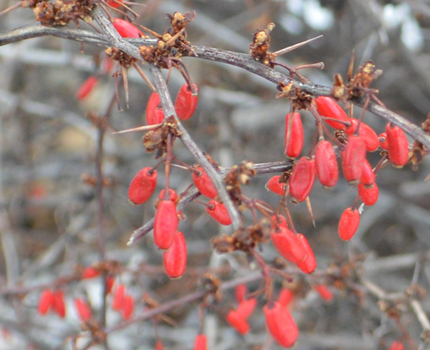by Todd Rutherford
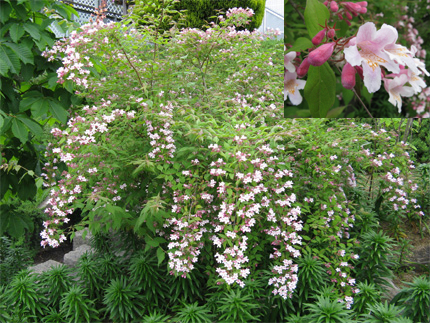
I recently discovered a flowering shrub that I thought was a new introduction, but has actually been a gardening staple for generations. I thought it might be a new shrub on the block because I’ve not encountered it in any public or private gardens in our region. Some sources state, however, that it was familiar to gardeners from previous generations. This shrub would be none other than Kolkwitzia amabilis, commonly referred to as the Beauty Bush.
As the common name would imply, Beauty Bush provides a stunning display of gorgeous bell-shaped pink flowers with yellow throats in late spring. The habit of Beauty Bush is vase shaped with sprawling, upright stems. It grows 10-15’ high and 12-15’ wide at maturity. This size would make it a good candidate for a large yard that needs a flowering shrub along the sides or back fence areas. Consider it as a choice for a large flowering hedge.
Best of all, this shrub is drought tolerant, though it can handle moderate watering, and prefers well drained soil. It can grow in full sun to filtered shade, but flowers best in full sun. Luckily for Colorado gardeners it tolerates clay soil and is adaptable to varied soil pH.
PLANT STATS
Scientific Name: Kolkwitzia amabilis
Plant Type: Deciduous Shrub
Mature Height: 10-15’
Mature Spread: 12-15’
Cold Hardiness Zone: 4 – 8.
Water Requirement: Medium, but has moderate drought tolerance. Give it an occasional deep soaking.
Exposure: Sun (will tolerate filtered shade)
Flower Color & Bloom Time: Pink. Spring.
Winter Interest: Exfoliating bark on mature stems.
Best Features: Profusion of small, pink, bell-shaped flowers in spring. Tolerates clay soil, grows in a wide range of soil conditions.
Disadvantages: Twiggy, wild look in winter may be undesirable for some.
Maintenance Tip: Prune out dead wood to reduce twiggy appearance. However keep in mind that it blooms from old wood.
Availability and Sizes: This plant seems to be regularly available. Various cultivars to choose from.
Wildlife Value: unknown
Have you used this shrub in your landscapes? If so, please comment on your experiences below.
This is the official blog of Outdoor Design Group, Colorado Landscape Architects. For more information about our business and our services, click here.
Related Posts:
by Matt Corrion
Two weeks ago I took a road trip to Phoenix to visit some old friends. We had an amazing time! The desert landscape is so interesting. Since I was visiting in late March, I was not subjected to the 100 degree + temperatures that come in summer, it was a comfortable 80 degrees most of the time.
My friends Brian and Colleen were nice enough to allow me to stay with their family. I brought my camera everywhere, with an eye on photographing and studying the landscape to see what ideas could be incorporated into our landscape designs back home in Colorado. Below I list some of the highlights of places I visited and observed.
Residential Landscapes
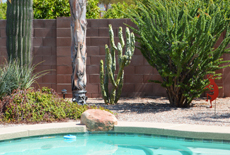
Brian and Colleen’s back yard with “totem pole” cactus – Beautiful!
Saw some interesting things- good and bad… Most homes have no lawn in the front yard, and large back yards typically have a limited amount of lawn. I think this is a good approach that saves water.
So what was used in place of lawn? It seems that at least 50% of the homes have swimming pools, and I saw some very well designed large outdoor patios and outdoor living spaces. For the landscaped areas, the ground cover of choice is small rock mulch (about 3/8″, angular rock).
Within the landscaped areas, I thought some of the plantings were a little thin. Creeping groundcovers, ornamental grasses, and massings of plants could be used more effectively to help cover the rock areas. Other features used in place of lawns were sport courts, outdoor kitchens, and shade structures.
Visiting the Desert Botanical Garden in Phoenix
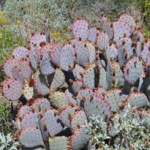
Purple Prickly Pear at the Desert Botanical Garden
This is truly an amazing garden! So many interesting cacti, agave, succulents, and native desert landscaping. They also were featuring some incredible glass sculptures by Dale Chihuly. I highly recommend visiting this garden if you are ever in the area! They have a great Facebook page as well, check it out.
Highway and Roadside Landscaping
One of the more striking features as you drive through Phoenix (and it is a very automobile dependent city) are the large swaths of roadside landscaping along the highways. Most of these areas are highly maintained slopes of rock with a few plants here and there.
My friends told me that there is a constant battle trying to eradicate the weeds from the rock- seems like a silly design solution to me. The nicer areas, in my opinion , had more plants grouped together in random, natural plantings. Other areas had formal planting in patterns and rows, or even just different color rock placed in patterns…

Aerials of Phoenix highway landscaping. Left- one of the nicer designs I saw, with random natural plantings. Right- this section had no plantings, with patterns of colored rock- not a fan of this approach.
Touring Local Nurseries
I had a chance to tour a local suburban Phoenix Nursery. I was interested to see what plants and materials were commercially available. I was happy you see that the trend of edible landscaping was equally as popular in Phoenix as it is in Denver, with a large selection of herbs, fruit trees, and other culinary delights.
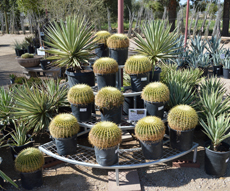
Agave, yucca, and cacti at a local suburban nursery
This nursery also had an impressive collection of sculpture and pottery- These items can add interest to a residential or commercial landscape, require little maintenance, and can serve as interesting focal points to the eye that break up large areas of rock.
One of the more interesting items for sale were packages of two Praying Mantis eggs- for natural pest control.
Hiking in the Superstition Wilderness
On my last day in the Phoenix area, my friend Brian and I went hiking in the Superstition Wilderness area. This turned out to be a very challenging hike to the top of the “flatiron” with amazing views and even more amazing native plants! I couldn’t help but think, – Why couldn’t some of those roadside highway areas be allowed to naturalize like some of this wild landscape, which received no maintenance and no irrigation?
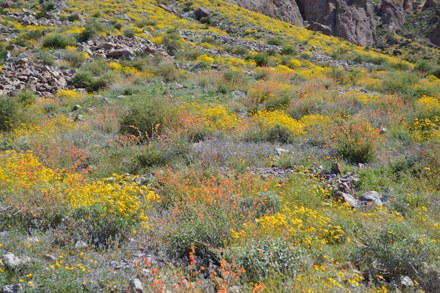
Native wildflowers- the orange flowers are Desert Mallow (Sphaeralcea ambigua), which grows great in my Denver garden!
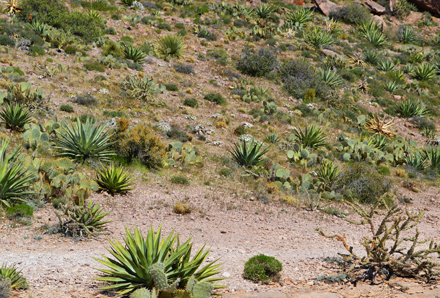
Native landscaping in the Superstition Wilderness area- Why can’t the highway roadside areas be naturalized like this?
This is the official blog of Outdoor Design Group, Colorado Landscape Architects. For more information about our business and our services, click here.
Related Posts:
